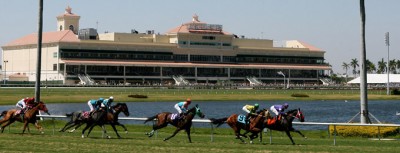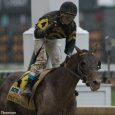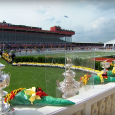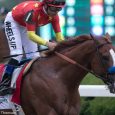The Gulfstream Park winter meet begins with the Claiming Crown, continues with the Sunshine Millions and includes several key 3-year-old prep races leading up to the Florida Derby (G1). Oh, and along the way, it features the $16 million Pegasus World Cup (on Jan. 27).

Yes, the winter racing season is here, and the best winter race meet in the country is ready to roll at Gulfstream Park, with the 2017-18 Gulfstream Champions meet running from Dec. 2 to April 1. As always, Gulfstream will feature the best trainers, jockeys, turf races and stakes races available at this time of year, making it a must-bet track for all serious horseplayers and handicappers for the next several months.
The Gulfstream meet customarily begins with horses shipping to Florida from all over the East and Midwest to join the cream of the local crop that has been competing at Gulfstream and Calder (“Gulfstream Park West”). Generally speaking, the shippers from places like Kentucky and New York have a class edge on the local horses, but that is not always the case anymore, with competitive horses at nearly all levels being sent out by several local trainers. This is especially true early in the Gulfstream meet throughout the month of December, when many of the snowbirds are coming off layoffs and are still shipping in and getting acclimated to the Gulfstream Park track and to Florida’s warm winter climate.
The middle part of the Gulfstream Park meet is when the premier action really gets going. January ushers in the time when the out-of-town barns come to life, as the quality of racing elevates to its highest level of the year in South Florida. This is usually the three months from the New Year until the Florida Derby.
Of course, the Gulfstream Park meet — or any other meet for that matter — will be a lot more enjoyable if you win races and cash tickets. Please read on for handicapping tips, angles and winning trends at Gulfstream Park, based on the track’s prevailing biases and running style preferences.
Best of luck and enjoy the great Championship meet!
Gulfstream Park Handicapping Tips
Here is a look at some categories that a horseplayer can use to help narrow down the choices and separate the pretenders from the contenders in order to further enjoy the season’s best horseracing at Gulfstream.
Gulfstream Park’s Prevailing Biases
It will pay dividends for any handicapper to know Gulfstream’s prevailing biases and to pay attention to certain other meet-specific tips that have proven to be profitable in the recent past, going all the way back to when Gulfstream Park’s main track was reconfigured to a mile-and-an-eighth oval prior to the 2005 meet. There are a variety of good tips to give handicappers the building blocks to establish a winning edge at Gulfstream Park, including certain trends related to running styles, post positions and turf racing.
- When handicapping at Gulfstream, always be acutely aware that one-mile races on the main track are single-turn races. This makes a big difference, because the one-mile races at Gulfstream play much more like sprints than the two-turn route races at Gulfstream. In other words, the GP one-mile races look a lot more like the track’s seven-furlong races than the track’s 1 1/16-mile races). The move back and forth from 7F to one mile is very manageable for most horses at Gulfstream, whereas the move from one mile to 1 1/16 miles or 1 1/8 miles amounts to a significant stretchout.
- In terms of favorable post positions, Gulfstream features strong preferences on the main track in both sprints and routes. Two-turn route races favor inside posts, while the one-turn races, especially one-mile races, give an advantage to outside horses. Some of the prime golden rules at Gulfstream Park are to stay away from outside posts in main track two-turn routes (anything outside post 6) and to stay away from far inside posts in dirt miles. Don’t bet the rail horse at all in any one-turn race at 6 1/2 furlongs or longer, because that post shows terrible win percentages and ROIs for the last decade.
The above two axioms cannot be repeated often enough, because these elements, when added together with winning running styles and trainer trends, can provide you the framework for what you’ll need to consistently do well at Gulfstream.
For the seventh year, Gulfstream will be carding main track route races at the 1 1/16-mile, two-turn distance. This was an important change made by adding an alternate mid-stretch finish line. The move was necessitated after two-turn route racing had been conducted at no less than 1 1/8 miles for the previous six years after the main track was renovated to its current layout, much to the dismay of horsemen and bettors alike.
Especially in dirt routes run at 1 1/8 miles, you probably will need an inside post in order to have an optimal chance to win. The inside post position favoritism is present at the 1 1/16-mile distance on the Gulfstream main track, but it is not as dramatic as at 1 1/8 miles.
Main Track Running Style Preferences
Gulfstream Park dirt races tend to favor horses with early speed, or at least tactical speed, at all distances. Deep closers generally don’t do well on this main track, and inside posts and rail-skimming trips are usually not an advantage. Gulfstream one-turn dirt races favor outside paths, while Gulfstream two-turn races favor inside posts and paths. Either way, give preference to horses capable of running in the front-half of the field from a pace perspective.
Turf Racing
Now let’s move to the grass, where a large part of the action takes place each winter at Gulfstream. Like many turf courses, the Gulfstream turf usually favors horses with a good turn-of-foot in the stretch. More so than elsewhere, however, it is difficult to go wire-to-wire in Gulfstream turf routes. In sprints, it is totally the opposite. Gulfstream runs five-furlong turf sprints and, in those races, you really need to have speed, or at least tactical speed, in order to have a decent chance to win.
One fairly unique thing that is consistent at Gulfstream and different from other places is that outside posts — including far outside posts — are okay at Gulfstream. Whether it is a turf sprint or a turf route, horses can win from far outside posts and a horse drawing post 12, for example, is not receiving a death sentence at Gulfstream.

For many years, the Gulfstream grass course was one of the most difficult courses in the country to win on in front-running fashion in routes. While speed is still not an advantage in Gulfstream turf routes, it is no longer the kiss of death it used to be. Prior to the 2015-2016 winter meet, the Gulfstream turf course was resurfaced, and that resurfacing had a major impact on the firmness of the course. The Gulfstream turf course no longer retains water the way it used to before the resurfacing, when it was a softer turf course that was brutal for early speed.
Formerly, horses on the turf course rarely ever went two turns on the lead and won. For the last two seasons, however, it is not the same. The fields in turf races are more spread out, less bunched-up, and front runners now have a better chance to extend their lead on the pace and occasionally go all the way. As the new root system of the turf course grows and matures, Gulfstream’s turf routes might very well return to favoring closers the way they used to, but for now, handicappers must consider all running styles in turf routes — not just the late runners — because speed horses can now win wire-to-wire.
If you must bet a Gulfstream turf frontrunner, at least go for either a horse with a chance to be the lone speed in the race, or do so on a day when the turf rails are moved out from the hedge a considerable distance (on the outer turf course). The further out the turf rails are, the better the chance for front-running winners. The turf rails are always publicly announced every racing day.
The position of the turf rails on the Gulfstream grass course, which has been divided into inner and outer turf courses to help the condition of the course stay good throughout the long meet, is key for the chances of an early speed grass horse. Since they are always moving the turf rail around, you need to be aware of where the turf rail is before you consider a front-runner’s chances on turf.
At Gulfstream on the grass, unlike on the dirt, a horse’s chances of success are based more on running style than post draw. Far outside posts are pretty much as good as inside posts, therefore it is running style that turns out to be more of a key determining factor as to how well a horse can be expected to run on the Gulfstream lawn.
One key distinction horseplayers must make in their Gulfstream handicapping has to do with Gulfstream’s commonly-run turf distance of 7 ½ furlongs. Because it is less than a mile, that distance is classified as a sprint by many outlets that compile racing statistics. However, all that classification serves to do is to mess up all of Gulfstream’s turf stats for turf sprints and routes.
Because these races are around two turns, the 7 ½-furlong turf races must be lumped into the route category, not the sprint category. The 7 ½-furlong races run like short routes, not like long sprints. They have absolutely nothing to do with Gulfstream’s true turf sprints, which are all run at five furlongs.
In Gulfstream’s ever-increasing number of short turf sprints (five furlongs), again it is running style and not post position that plays the greatest role in the results — and in the chances of success or failure for different horses in these races. Instead of focusing on post position in five-furlong turf sprints, you must instead focus on running style.
The five-furlong Gulfstream turf sprints are dominated by speed horses, or at least horses that can stay within a couple lengths of the early lead. It is extremely difficult for horses to have any success in these turf dashes from far off the pace or from the back half of the field. In terms of posts, the rail (post 1) is not great at five panels on the turf, but the other inside posts 2-4 — as well as pretty much any post position in the gate — are all okay. If you do bet a horse from the rail in these races, make sure the horse has early speed. Otherwise, the chances are dim for any turf sprinter from post 1 at Gulfstream.
Wrap-Up
Have a great meet at Gulfstream this season, and enjoy being a racing fan this winter. Put Gulfstream Park at or near the top of your wagering menu from now until the spring, and you are bound to do well by following these simple tips and trends to help you win at winter’s best race meet. Best of luck, and enjoy!




